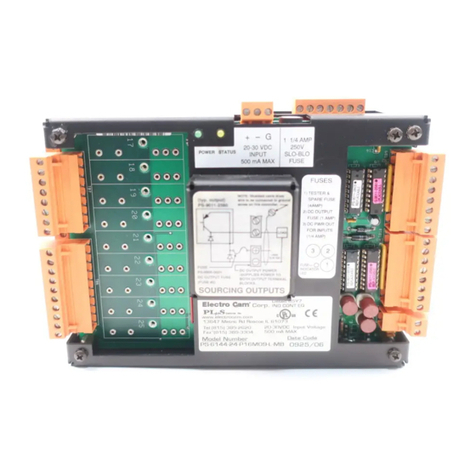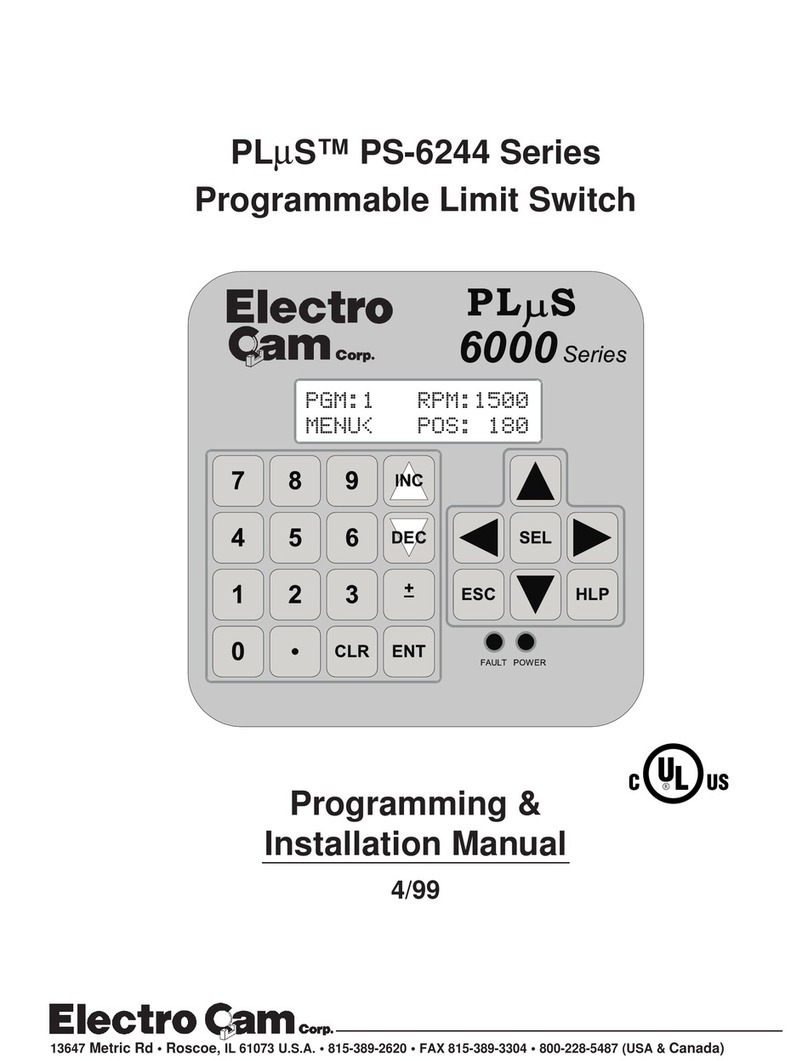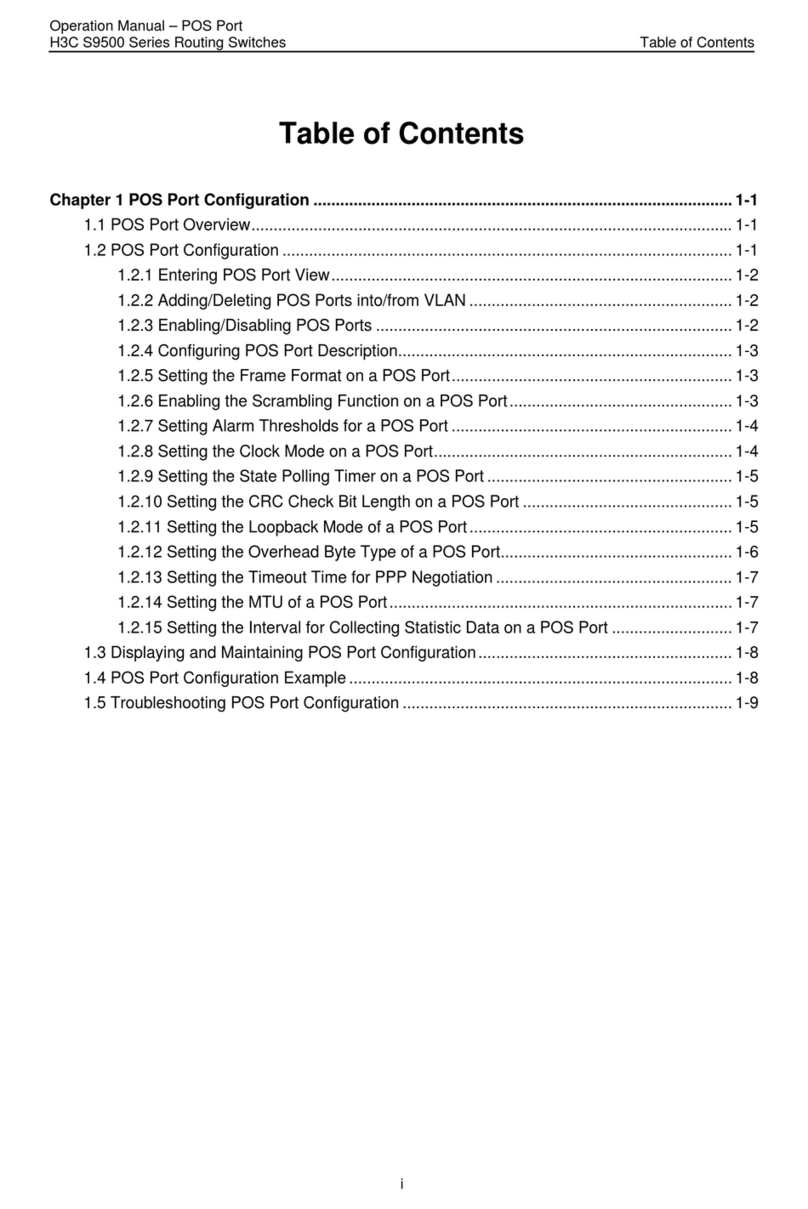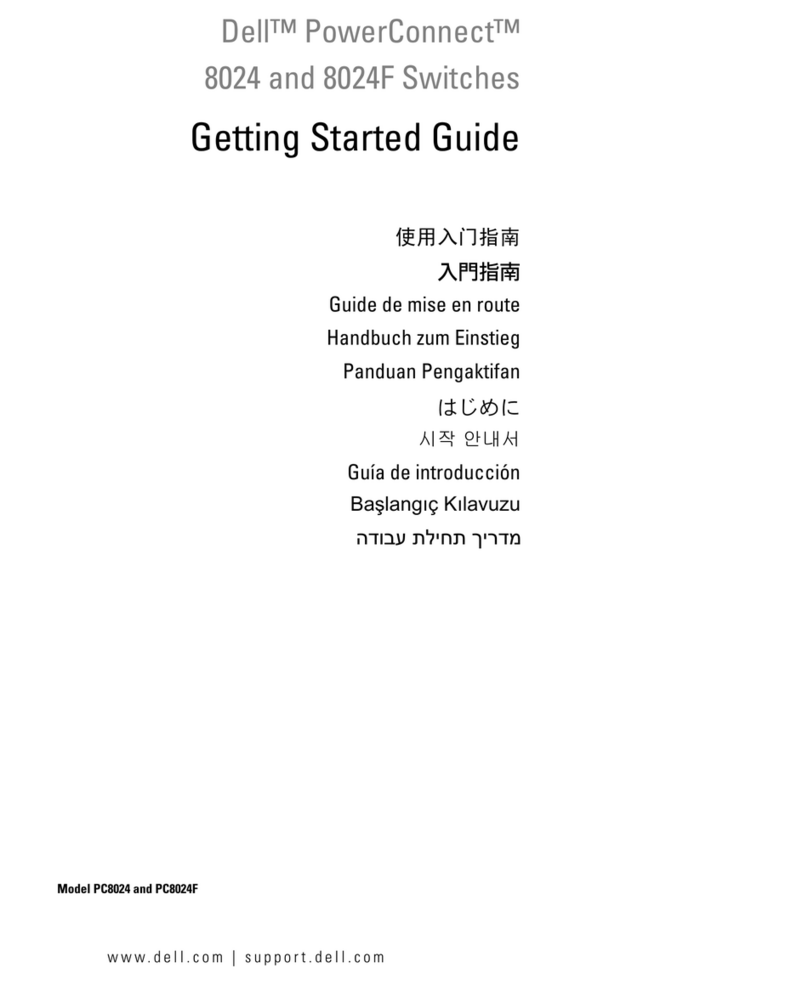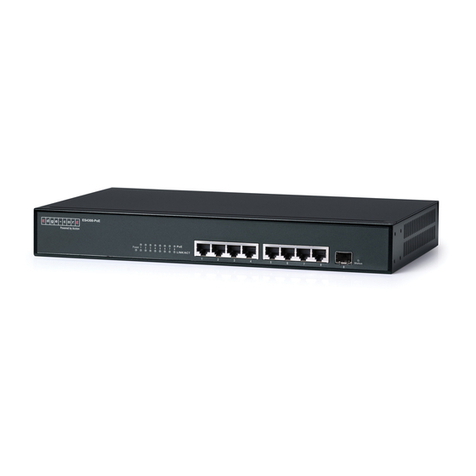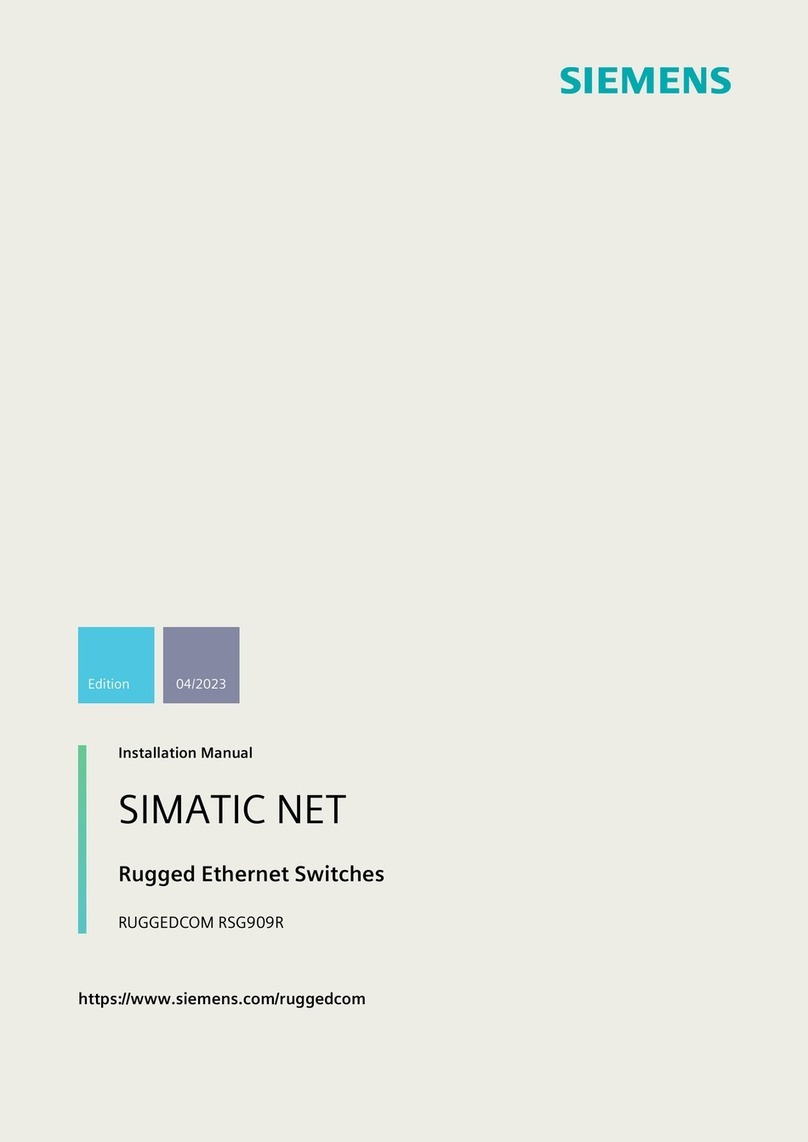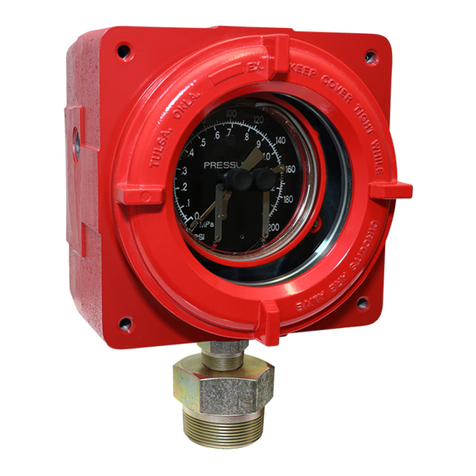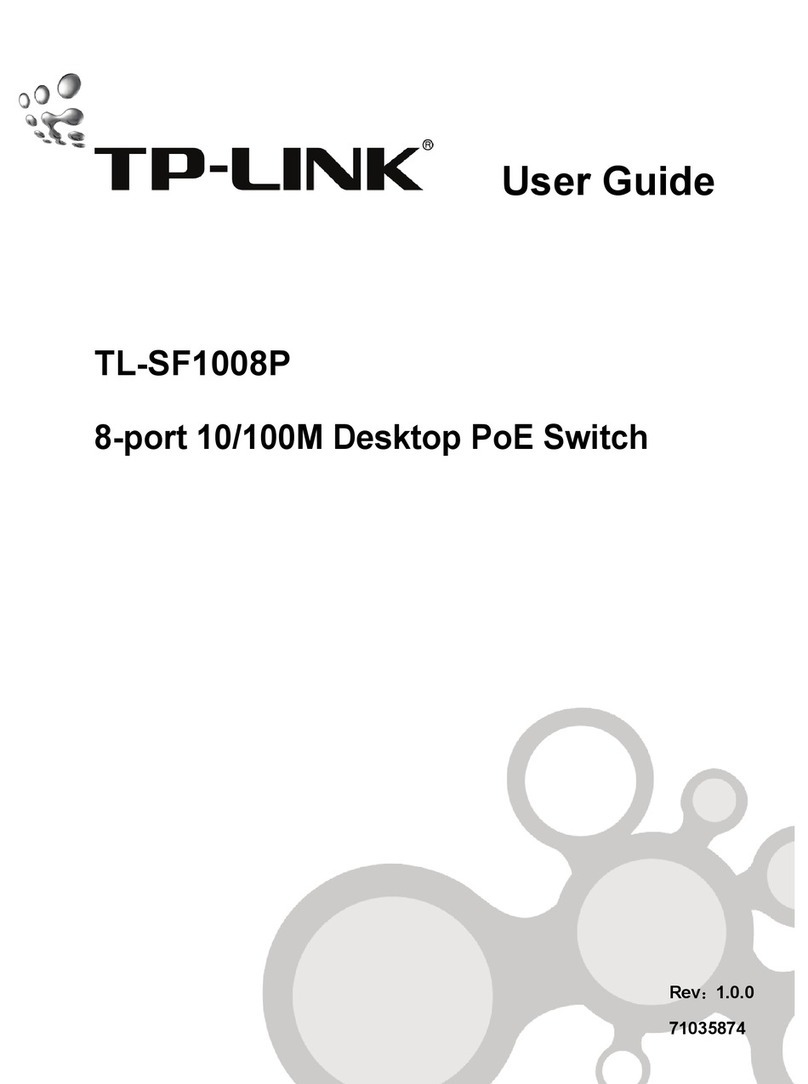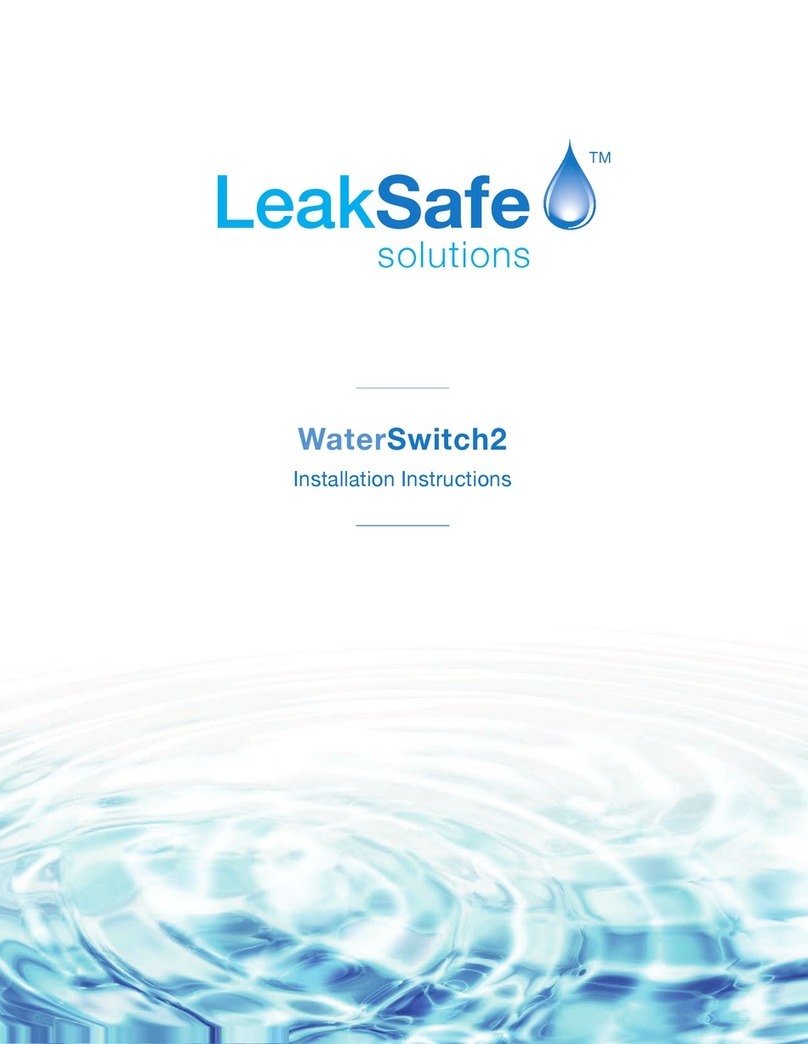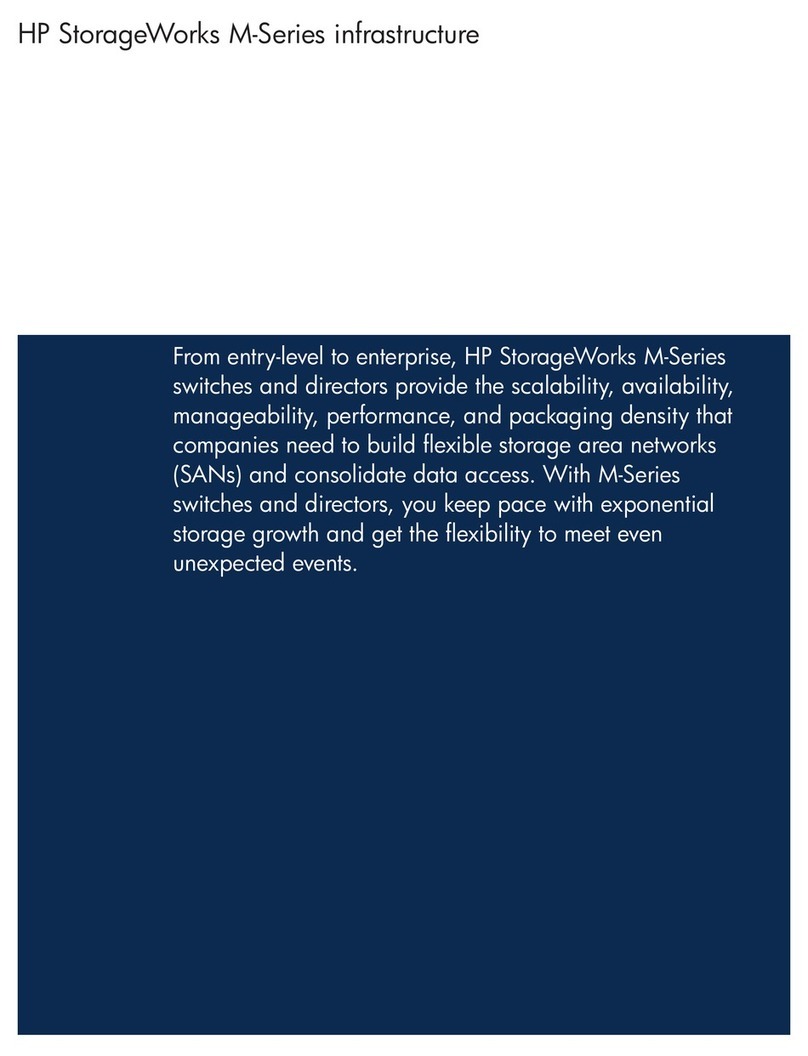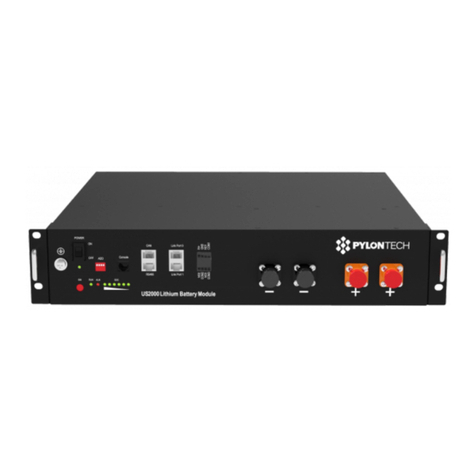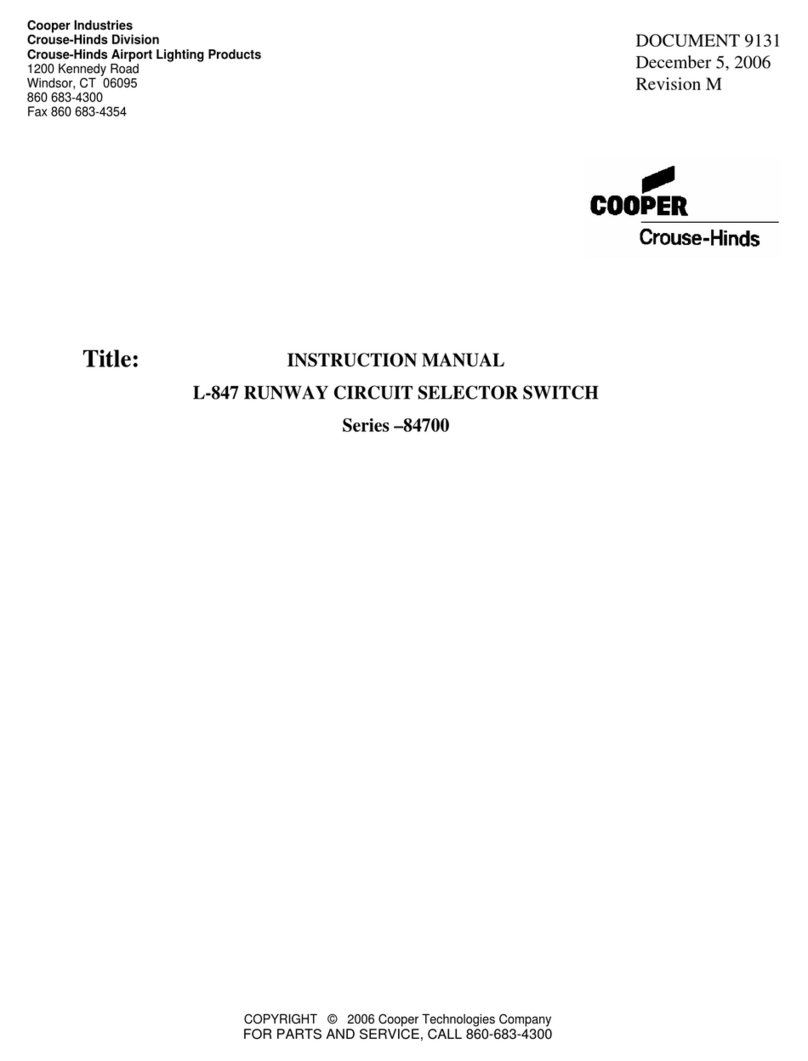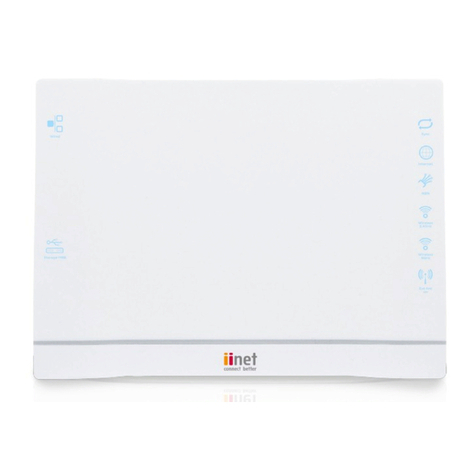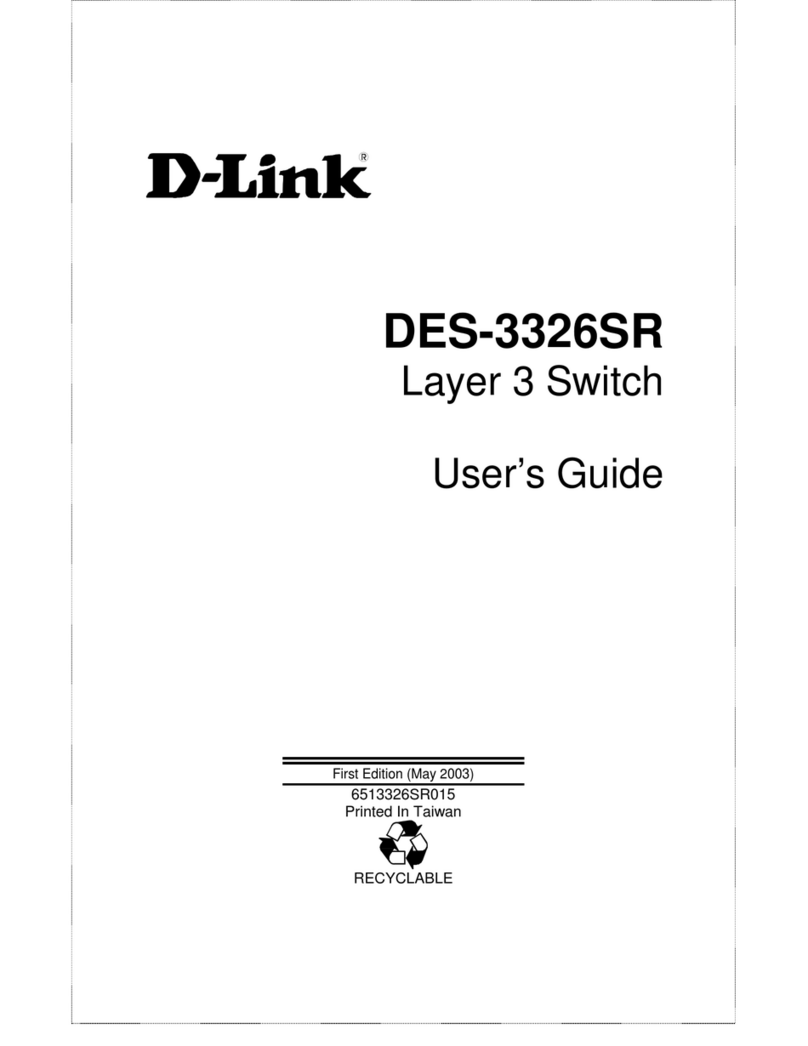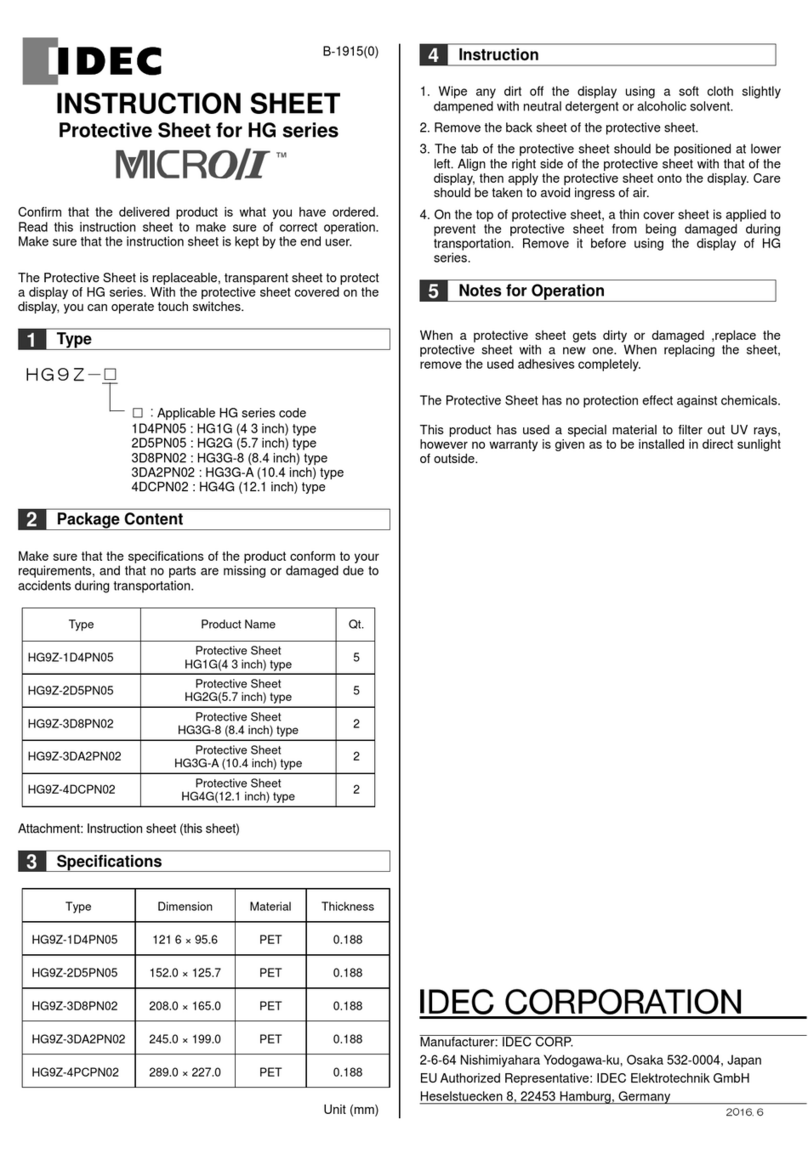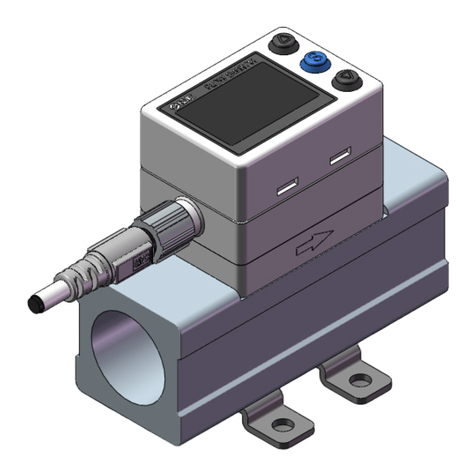Electro Cam PLUS PS-5000 Series User manual

Programming &
Installation Manual
January 2006
PLµS®PS-5000 Series
Programmable Limit Switch
13647 Metric Rd • Roscoe, IL 61073 USA • 815/389-2620 • FAX 815/389-3304 • 800-228-5487 (U.S.A. and Canada)

Copyright © 2001
All Rights Reserved
Neither this document nor any part may be reproduced or transmitted in
any form or by any means without permission in writing from the publisher.
®,PLµS®,SLIMLINE®, and PLµSNET®are all registered trademarks of

PS-5000 Quick Start Guide
These five basic programming settings are required
for operation of the Electro Cam Corp. PS-5000 controller
1) Scale Factor
The default value is 360 increments per revolution. To increase or decrease this number press FCN
key, the “0” key, then ENT. Press CHN key until SF is displayed above CHN key. Enter new scale
factor and press ENT. Press POS/RPM key to exit this function.
2) Direction of Increasing Rotation
Turn the resolver or encoder, making sure controller position increases. If not, change the direction
of rotation. Press FCN key, the “0” key, then ENT. Press CHN key until “dr” is displayed above CHN
key. Press PULSE key to toggle between CL (clockwise) and CCL (counterclockwise). Press POS/
RPM key to exit this function.
3) Setting Displayed Position to Match Actual Machine Position “FCN2: OFFSET”
With your machine set at zero or a known position, make sure the displayed controller position is
correct. If not, press FCN key, the “2” key, then ENT. Enter the current machine position and press
ENT key. Press POS/RPM key to exit this function.
4) Setting On/Off Setpoints for Each Output
Press the CHN key, then select the channel you wish to program by pressing the number keys. Press
ENT key. Press ON key, enter the position at which you want the output to turn on, then press ENT
key. Press OFF key, enter the position at which you want the output to turn off, then press ENT key.
Press POS/RPM key to exit this function.
Note: Repeat step 4 until you have entered all the setpoints in the channels you wish to program.
You can enter multiple on/off setpoints in a channel, but they cannot overlap.
5) To View or Check On/Off Setpoints Entered for an Output
Press CHN key, then select the output you wish to view by pressing the number keys. Press ENT key.
Press the right VIEW key; the on setpoint will be displayed and the LED above the ON key will be on.
Press VIEW key again; the off setpoint will be displayed and the LED above the OFF key will be on.
If you have multiple setpoints in the same channel, keep pressing the VIEW key and the display will
cycle through the other on/off setpoints. Press POS/RPM key to exit this function.
You are now ready to run the controller with your outputs turning on and off at the specified positions.
If you wish to apply additional conditions to enable your outputs, such as speed compensation, timed
outputs, or motion detection, refer to the appropriate section of this manual for details. Depending on
your model, it may be possible to enable your outputs based on an input from another device.

Table of Contents
Section—Introduction
Basic Cam Switch Operation . . . . . . . . . . . . . . . . . . . . . 1-1
Standard Features . . . . . . . . . . . . . . . . . . . . . . . . . . . 1-1
Optional Features . . . . . . . . . . . . . . . . . . . . . . . . . . . 1-2
Model Summary . . . . . . . . . . . . . . . . . . . . . . . . . . . 1-3
Section 2—Dimensions & Component Locations
Controllers with External I/O Module Rack
5001, 5101, 5004, 5104, 5034, 5134 . . . . . . . . . . . . 2-1
Controllers with I/O Modules on Controller Back
5021, 5121, 5024, 5124 . . . . . . . . . . . . . . . . . . . . . . 2-2
Controllers with Built-In Transistor I/O Chips
5011, 5111 . . . . . . . . . . . . . . . . . . . . . . . . . . . . . . . . 2-3
Section 3—Wiring
Logic Terminal Strip Wiring . . . . . . . . . . . . . . . . . . . . . . 3-1
External I/O Racks (5001, 5101, 5004, 5104)
16 Module I/O Rack—Standard . . . . . . . . . . . . . . . . 3-2
16 Module I/O Rack—Analog . . . . . . . . . . . . . . . . . . 3-2
16 Module I/O Rack—M16 Slimline . . . . . . . . . . . . . 3-2
24 & 48 I/O Rack . . . . . . . . . . . . . . . . . . . . . . . . . . . 3-3
I/O Modules on Controller (5021, 5121, 5024, 5124) . . 3-4
Module Wiring, Outputs . . . . . . . . . . . . . . . . . . . . . . . . . 3-4
Sinking/Sourcing Defined . . . . . . . . . . . . . . . . . . . . . . . 3-5
Module Wiring, Inputs . . . . . . . . . . . . . . . . . . . . . . . . . . 3-5
Input Wiring, 3-Wire Sensors . . . . . . . . . . . . . . . . . . . . . 3-5
Built-In Transistor I/O Chips (5011, 5111)
Description . . . . . . . . . . . . . . . . . . . . . . . . . . . . . . . . 3-6
Output Wiring, Sourcing . . . . . . . . . . . . . . . . . . . . . . 3-7
Output Wiring, Sinking . . . . . . . . . . . . . . . . . . . . . . . 3-8
Output Wiring to PLC . . . . . . . . . . . . . . . . . . . . . . . . 3-9
PS-5X34 Controller & 32 DC Output Rack . . . . . . . 3-10
PS-5X34 Output Rack Layout . . . . . . . . . . . . . . . . 3-11
PS-5X34 Wiring to PLC's . . . . . . . . . . . . . . . . . . . . 3-12
PS-5X34 Output Rack Transistor Array Chips . . . . 3-13
Resolver Wiring . . . . . . . . . . . . . . . . . . . . . . . . . . . . . . 3-14
Cable for Stainless Steel Resolver . . . . . . . . . . . . . . . 3-15
Encoder Cable Installation . . . . . . . . . . . . . . . . . . . . . . 3-16
Section 4—Programming, Standard Features
Access Levels . . . . . . . . . . . . . . . . . . . . . . . . . . . . . . . . 4-1
Keyboard Description . . . . . . . . . . . . . . . . . . . . . . . . . . 4-2
Output Setpoint Programming . . . . . . . . . . . . . . . . . . . . 4-3
Master Level Programming
FCN 0 Programming Enable . . . . . . . . . . . . . . . 4-4
dr Direction of Rotation . . . . . . . . . . . . . . . . 4-4
SF Scale Factor . . . . . . . . . . . . . . . . . . . . . . 4-4
P1 & P2 Keyboard Enable . . . . . . . . . . . . . . . . . . 4-4
tb Time Base for Output Timing . . . . . . . . . 4-5
Enhanced Position/RPM Display Logic . . . . . . . . . . 4-5
dd Display Default . . . . . . . . . . . . . . . . . . . . 4-5
tr Toggle RPM . . . . . . . . . . . . . . . . . . . . . . 4-5
rU rPM Display Update Frequency . . . . . . . 4-6
ct, cS, cA Communications Parameters . . . . . . . . . . 4-6
FCN 6 Output Channel Access . . . . . . . . . . . . . 4-7
FCN 7 Motion ANDing . . . . . . . . . . . . . . . . . . . . 4-8
FCN 8 Subdividing Outputs . . . . . . . . . . . . . . . . 4-9
FCN 9 Enable Inputs and Modes . . . . . . . . . . . 4-9
Setup Level Programming
FCN 1 Motion Setpoints . . . . . . . . . . . . . . . . . . 4-10
FCN 2 Offset . . . . . . . . . . . . . . . . . . . . . . . . . . 4-10
FCN 3 Program Number . . . . . . . . . . . . . . . . . 4-10
FCN 4 Speed Compensation, Standard . . . . . 4-12
Speed Compensation, Negative . . . . . 4-12
FCN 5 Timed Outputs . . . . . . . . . . . . . . . . . . . 4-13
Section 5—Programming, Optional Features
Leading Trailing Speed Comp (“-L”)
FCN 0 Speed Comp Type . . . . . . . . . . . . . . . . . 5-1
FCN 4 Leading/Trailing Speed Comp . . . . . . . . 5-1
Analog Output (“-A”)
FCN 1 Analog Offset & High RPM . . . . . . . . . . . 5-2
Outputs Based on Direction of Rotation (“-D”)
Direction ANDing . . . . . . . . . . . . . . . . . . . . . . . . . . . 5-2
Direction Hysteresis . . . . . . . . . . . . . . . . . . . . . . . . . 5-2
Gray Code Output (“-G”)
Gray Code Conversion Ladder . . . . . . . . . . . . . . . . . 5-3
FCN 4 Gray Code Speed Comp . . . . . . . . . . . . 5-3
Extra Program Storage (“-F”)
Pulses/Programs Available . . . . . . . . . . . . . . . . . . . 5-4
Program Number Displays . . . . . . . . . . . . . . . . . . . . 5-4
FCN 3 Program Number Changes . . . . . . . . . . 5-5
Viewing/Editing Program . . . . . . . . . . . . . . . . . . . . . 5-6
Phase Mark Registration (“-P”)
Examples and Adjustment Methods . . . . . . . . . . . . . 5-7
Input Information . . . . . . . . . . . . . . . . . . . . . . . . . . . 5-8
CHN 80 Auto-Center Registration . . . . . . . . . . . . 5-9
CHN 81 Adjust Registration Center . . . . . . . . . . . 5-9
Reversal of Centering Logic . . . . . . . . . . . . . . . . . . 5-10
“OFF” Logic Examples . . . . . . . . . . . . . . . . . . . . . . 5-10
Appendix
Output Grouping & Modes
Introduction . . . . . . . . . . . . . . . . . . . . . . . . . . . . . . . . A-1
Configuration Examples . . . . . . . . . . . . . . . . . . . . . . A-2
Mode 0 . . . . . . . . . . . . . . . . . . . . . . . . . . . . . . . . . . . A-3
Mode 1 . . . . . . . . . . . . . . . . . . . . . . . . . . . . . . . . . . . A-4
Mode 2 . . . . . . . . . . . . . . . . . . . . . . . . . . . . . . . . . . . A-6
Mode 3 . . . . . . . . . . . . . . . . . . . . . . . . . . . . . . . . . . . A-8
Mode 4 . . . . . . . . . . . . . . . . . . . . . . . . . . . . . . . . . . A-10
Error Messages . . . . . . . . . . . . . . . . . . . . . . . . . . . . . . A-12
Communication Port Wiring . . . . . . . . . . . . . . . . . . . . . A-14
Encoder Position vs. Degrees . . . . . . . . . . . . . . . . . . . A-15
60 Pulse Disc—Position vs. Degrees . . . . . . . . . . . . . A-15
Alternate Functions . . . . . . . . . . . . . . . . . . . . . . . . . . A-16
Alt Fcn 1 Transducer Position
Alt Fcn 2 Logic Input Status
Alt Fcn 3 Offset Value
Alt Fcn 4 60 Pulse Disc
Alt Fcn 1002 Keyboard Test
Alt Fcn 1003 LED Display Test
Alt Fcn 1004 Watchdog Timer Test
Alt Fcn 1005 Control Model Info
Alt Fcn 1006 Options & Rev. #
Alt Fcn 7000 Restore Defaults
Alt Fcn 7001 Clear Setpoints
Alt Fcn 7999 EEPROM Test
Remote Display Installation . . . . . . . . . . . . . . . . . . . . . A-17
Specifications . . . . . . . . . . . . . . . . . . . . . . . . . . A-18
Index

WARRANTY
1. Electro Cam Corp. warrants that for a period of twelve (12) months from the date of shipment to
the original purchaser, its new product to be free from defects in material and workmanship and
that the product conforms to applicable drawings and specifications approved by the Manufac-
turer. This warranty period will be extended on Distributor or OEM orders to a maximum of
eighteen months to take into consideration Distributor or OEM shelf time.
2. The remedy obligations of Electro Cam Corp. under this warranty are exclusive and are limited to
the repair, or at its option, the replacement or refund of the original purchase price of any new
apparatus which proves defective or not in conformity with the drawings and specifications. Ship-
ment of the claimed defective product to Electro Cam Corp. shall be at the cost of the consumer.
Shipment of the repaired or replacement product to the consumer shall be at the cost of Electro
Cam Corp. All claims must be made in writing to Electro Cam Corp., 13647 Metric Road, Roscoe,
IL 61073 USA.
3. In no event, and under no circumstances, shall Electro Cam Corp. be liable for:
a. Any product damaged or lost in shipment. Inspection for damage should be made before
acceptance or signing any delivery documents releasing responsibility of the delivering car-
rier.
b. Product failure or damages due to misuse abuse, improper installation or abnormal condi-
tions of temperature, dirt or other contaminants as determined at the sole discretion of Electro
Cam Corp.
c. Product failures due to operation, intentional or otherwise, above rated capacities as deter-
mined at the sole discretion of Electro Cam Corp.
d. Non-authorized expenses for removal, inspection, transportation, repair or rework. Nor shall
the manufacturer ever be liable for consequential and incidental damages, or in any amount
greater than the purchase price of the equipment.
4. There are no warranties which extend beyond the description on the face hereof. This warranty is
in LIEU OF ALL OTHER WARRANTIES, EXPRESSED OR IMPLIED INCLUDING (BUT NOT
LIMITED TO) ANY IMPLIED WARRANTIES OF MERCHANTABILITY OR FITNESS FOR A PAR-
TICULAR PURPOSE, ALL OF WHICH ARE EXPRESSLY DISCLAIMED. Any legal proceeding
arising out of the sale or use of this apparatus must be commenced within (18) months of the date
of shipment from the manufacturer.

Basic Cam Switch Operation
Basic Cam Switch Operation
A PLμScontrol’smain purpose isto operate outputsin a
manner that simulatescam switches. The drawing to the
right illustratesthe operation of acam switch. Itsfunction is
to switch the load on and off at the same rotary positionsof
the cam shaft during each revolution of that cam shaft. The
rotating cam shaft isdriven by amachine at a1:1 ratio, so
that the on / off positionsof the cam switch alwaysmatch
specific positionsin the machine cycle. However, cam limit
switcheshave the following disadvantages: unreliable
(wear), hard to adjust (machine must be stopped during
adjustment), and they cannot run at high speedsbecause
of contact bounce and excessive mechanical wear.
PLμScontrolsovercome these basic cam switch problems.
They have no moving wear parts, they are easy to adjust
from the keyboard with the machine running or stopped,
and they can operate at speedsup to 3000 RPM. They also
add many capabilitiesfar beyond simple cam switch logic. The limit switch will turn on and off at
the same cam degree positionsevery
cam revolution (every machine cycle)
Standard Product Features
Keyboard/Controller
The keyboard controller isthe main component of the PLμS
system. The front keypad and displaysprovide acomplete
user interface from which every aspect of the control’s
operation can be monitored and programmed. When
properly mounted with the gasket provided, the keyboard
meetsNEMA 4 standards. A clear silicon rubber boot
assembly isavailable to provide NEMA 4X protection for
installationswhere harsh washdown chemicalsare used.
Ease of Setup
All output position setpoint valuesare simply entered
through the numeric keypad. These setpointscan be
adjusted while the machine isrunning or stopped by using
the increment, decrement, or numeric keys. The keyboard
isalso used to synchronize the control’sposition to the
machine, eliminating the need to mechanically adjust the
resolver’sshaft position.
Multiple Programs
Depending on the model ordered, up to 64 different
programs, or Òjo brecipes” can be stored in the control’s
memory. Thisminimizesdown time for jobchange over
because simply changing program numbersmakesall of
the output setting changesrequired. Program numbersc an
be changed by mechanical switches; PLC’s(using the
hardware program select inputs); the keypad; or serial
communication messages.
Output Speed Compensation
Speed compensation allowsoutputsto compensate for the
response time of the controlled devicesby turning on earlier
as machine speedsincrease. Thiseliminatesthe need to
adjust output settingswhenever machine speedsare
changed. Using speed compensation often allowshigher
production speedsand eliminatesthe need for output
adjustments.
Motion ANDing
A speed range can be programmed into the controller, and
outputscan then be ANDed with the speed range so that
they will be disabled unless the machine speed iswithin the
range. Thiscan be used to turn off outputsif the machine
stops; disable outputsuntil the machine reachesaminimum
speed; or disable outputsif the machine goesabove a
specified maximum speed. A common use for thisfeature
isdisabling outputsto glue valvesso the flow of glue turns
off if the machine stops.
Timed Outputs
Outputscan be programmed to turn on at the programmed
“on”position and turn off when the specified time elapses,
rather than staying on until an “off”position isreached. The
result isaconstant output duration, regardless of machine
speed. The output will turn off when the “off”position is
reached if it hasn’t already timed out. Timed outputsare
used to drive deviceswhich require afixed time to perform
atask, regardless of machine speed.
1-1 Introduction
Introduction

1-2 Introduction
Selectable Scale Factor (resolversonly)
The number of incrementsper revolution (Scale Factor) is
programmed by the user. Standard controlshave a
maximum of 1024 incrementsper revolution and “-H”option
(high resolution) controlshave amaximum of 4096
incrementsper revolution. To make the control operate and
program in degrees, aScale Factor of 360 isused. In some
applicationsit isdesirable to use aScale Factor that defines
each increment as aspecific distance in engineering units
(ex: 1 inc = .1" of travel).
Output Groupingand Modesof Operation
Outputscan be subdivided into groupsand each group
can be associated with an input device. There are five
different modesof operation that can be selected for each
group. For example, some modesallow the group to activate
only when the corresponding input has signaled that product
ispresent. Glue control isatypical place where outputs
are disabled until product issensed as being present. For
details, see page A-1.
Standard Product Features(continued)
Optional Product Features
AnalogOutput, Ò-A ”
Unitswith thisoption can output an analog signal that is
linearly proportional to RPM. The analog signal level at
zero RPM can be programmed through the keyboard, as
well as the RPM that correspondsto maximum signal. No
measuring equipment isrequired for initial setup, and
calibration isnot needed. Typical usesare control of glue
pressure as machine speed changes, and speed matching
of other equipment to the machine being controlled.
OutputsBased On Rotation Direction, “-D”
In standard PLμScontrollers, outputswill turn ON/OFF
based on resolver position, regardless of which way the
resolver isturning. With the "-D" option, outputscan be
based on resolver rotation direction.
Large Program Memory, “-F”
Depending on the number of outputsordered, standard
controlscan store up to 64 programsconsisting of not more
than 1258output pulsestotal. Controlswith the “-F”option
increase thiscapacity by storing up to 256 programs
consisting of not more than 4589 output pulsestotal.
Gray Code Position Output, “-G”
The “-G”option provideseight bitsof position information
on the last eight outputs. This“gray code”output can be
connected to aPLC or other electronic control device,
eliminating the need for expensive accessory cards. The
PLC can then make control decisionsthat do not demand
afast response, while other PLμSoutputsdirectly control
devicesthat must operate quickly and consistently.
High Resolution, “-H”(resolversonly)
Controlswith thisoption can divide the resolver shaft
Serial Communication
Serial communication providesan RS-232 and an RS-485
communication port. Using PLμSNET software for IBM
compatible computers, available from Electro Cam Corp.,
the control’sentire program can be saved from the control
to adisk file or loaded from adisk file to the control. The
program can be printed or edited using the computer. It is
also possible to send individual communication commands
to the control, while running, to change settingsin the
program. The user must write appropriate software to
communicate at the individual command level.
Expanded Operator Access
Thisfeature givesthe operator access to motion detection
settings, offset, active program number, and speed
compensation.
NOTE: Serial Communication and Expanded Operator
Access were "-C" and "-E" optionsprior to date code
9740.
rotation into as many as 4096 increments. Standard
controlshave amaximum of 1024 increments.
Leading/TrailingEdge Speed Comp, “-L”
Thisoption allowsthe “on”and “off”edgesof output pulses
to be speed compensated by different amounts. High speed
gluing isacommon application where the “on”and “off”
edgesof the output signal have to be compensated by
different amounts.
Phase Mark Registration, “-P”
Phase mark registration allowsthe PLμScontrol to
determine if aproduct appearsbefore or after a
programmed timing window. If mis-registration occurs, the
product’stiming can be adjusted manually, or by aPLC or
similar controller interfaced to the PLuS control.
Caustic Washdown Boot, “-W”
The face of the keyboard israted NEMA 4X (meetsNEMA
1, 4, 4X, and 12). For additional protection against caustic
washdown, grease, oil, dirt, and normal wear, aclear
silicone rubber boot isavailable that fitsover and around
the keyboard. The back of the boot providesagood seal
between the back of the keyboard and the control panel.
The boot istransparent and pliable, allowing the keyboard
to be viewed and operated through it. Controlsordered
with the “-W”option are shipped with the boot fitted over
the keyboard. Bootsmay also be ordered separately and
installed in the field (#PS-4904-99-001).
Remote Display
A remote display which connectsto the RS-485 port is
available for unitsordered with both the “-C”and “-E”
options. Thisallowsposition and RPM information to be
displayed up to 1000 feet away from the controller.

1-3Introduction
PS-5000 SeriesModel Summary
PS-5021
PS-5121
PS-5024
PS-5124
These Models
Have I/O Modules
On Controller Back
PS-5001
PS-5101
PS-5004
PS-5104
PS-5034
PS-5134
These Models
Use External
I/O Module Racks
These Models
Use Built-In
I/O Transistor Chips
PS-5011
PS-5111
# of # of Output
Model Output Type Transducer OutputsProgramsModes? Options
PS-5001-10-016 Module Rack Encoder 16 64 no A, F, G, L, P, V, W, 20, 24
PS-5101-10-016 Module Rack Resolver 16 64 no A, F, G, H, L, P, V, W, 20, 24
PS-5001-10-024 Module Rack Encoder 24 48no F, G, L, V, W, 20, 24
PS-5101-10-024 Module Rack Resolver 24 48no F, G, H, L, V, W, 20, 24
PS-5001-10-048Module Rack Encoder 4824 no F, G, L, V, W, 20, 24
PS-5101-10-048Module Rack Resolver 4824 no F, G, H, L, V, W, 20, 24
PS-5004-10-016 Module Rack Encoder 16 64 yesA, F, G, L, P, V, W, 20, 24
PS-5104-10-016 Module Rack Resolver 16 64 yesA, F, G, H, L, P, V, W, 20, 24
PS-5004-10-024 Module Rack Encoder 24 48yesF, G, L, V, W, 20, 24
PS-5104-10-024 Module Rack Resolver 24 48yesF, G, H, L, V, W, 20, 24
PS-5004-10-048Module Rack Encoder 4824 yesF, G, L, V, W, 20, 24
PS-5104-10-048Module Rack Resolver 4824 yesF, G, H, L, V, W, 20, 24
PS-5011-10-N08Transistor, Sinking Encoder 864 no F, L, V, W, 20, 24
PS-5111-10-N08Transistor, Sinking Resolver 864 no F, H, L, V, W, 20, 24
PS-5011-10-N16 Transistor, Sinking Encoder 16 64 no F, G, L, P, V, W, 20, 24
PS-5111-10-N16 Transistor, Sinking Resolver 16 64 no F, G, H, L, P, V, W, 20, 24
PS-5011-10-P08Transistor, Sourcing Encoder 864 no F, L, V, W, 20, 24
PS-5111-10-P08Transistor, Sourcing Resolver 864 no F, H, L, V, W, 20, 24
PS-5011-10-P16 Transistor, Sourcing Encoder 16 64 no F, G, L, P, V, W, 20, 24
PS-5111-10-P16 Transistor, Sourcing Resolver 16 64 no F, G, H, L, P, V, W, 20, 24
PS-5034-10-032Transistor, Ext. Rack Encoder 3232yesF, G, L, V, W, 20, 24
PS-5134-10-032Transistor, Ext. Rack Resolver 3232yesF, G, H, L, U, V, W, 24
PS-5034-10-064 Transistor, Ext. Rack Encoder 64 16 yesF, G, L, V, W, 20, 24
PS-5134-10-064 Transistor, Ext. Rack Resolver 64 16 yesF, G, H, L, U, V, W, 24
PS-5021-10-M09 Moduleson Back Encoder 9 64 no A, F, L, V, W, 20, 24
PS-5121-10-M09 Moduleson Back Resolver 9 64 no A, F, H, L, P, U, V, W, 20, 24
PS-5024-10-M09 Moduleson Back Encoder 9 64 yesA, F, L, V, W, 20, 24
PS-5124-10-M09 Moduleson Back Resolver 9 64 yesA, F, H, L, P, U, V, W, 20, 24
Key To Option Selection
20-240 VAC: Change “-10-”to “-20-”.
24-24 VDC: Change “-10-”to “-24-”.
AAnalog output proportional to speed
FAdditional setpoint/program storage
GGray code position output
HHigh resolution, resolver only
LIndividual leading/trailing edge speed compensation
PRegister mark phasing
UCE mark - requires24VDC input
VVibration protective coating
WWashdown Boot

Controllersw/ External I/O Module Rack
2-1 Dimensions& Component Locations
PS-5001
PS-5101
PS-5004
PS-5104
PS-5034
PS-5134
Detailed View of
24 VDC Version
See Page 2-4
for Controller
Dimensions

2-2 Dimensions & Component Locations
PS-5021
PS-5121
PS-5024
PS-5124
Controllers w/ I/O Modules on Controller Back
LED HOLD
DOWN
SCREW
FUSE
4A
Slimline Modules
TOP
Detailed View of
24 VDC Version
See Page 2-4
for Controller
Dimensions

Controllers with Built-In Transistor I/O Chips
2-3 Dimensions & Component Locations
PS-5011
PS-5111
Detailed View of
24 VDC Version
See page 2-5
for Controller
Dimensions

PS-5021
PS-5121
PS-5024
PS-5124
PS-5001
PS-5101
PS-5004
PS-5104
PS-5034
PS-5134
Controller Dimensions
2-4 Dimensions& Component Locations

PS-5011
PS-5111
Controller Dimensions
2-5 Dimensions& Component Locations

3-1 Wiring
Logic Terminal Strip
(see pp. 2-1 thru 2-3 for location)
Program Select Switch and Cable:
Pt# PS-4901-01-XXX (XXX=FT)
DC power for accessories, typically photo sensors.
Terminals 1 and 2 are negative side of this supply
Program Enable key switch and cable:
PS-4902-01-XXX (XXX=FT)
Program Enable key switch and cable:
PS-4902-01-XXX (XXX=FT)
Input from photo sensor typically
To PLC or other electronic input
Logic Terminal Strip Wiring—Standard Controller
General Logic Input Information
The logic inputs, Terminals 2-7 & 9, are switched by a
current sinking path to Logic Common. They can be switched
by mechanical switches, relays, or NPN transistor outputs.
Logic input terminal voltage is approximately 12 VDC, and
4 mA of current are conducted through the switch to Logic
Common.
Program Select Inputs (Terminals 3, 4, and 5)
These inputs determine which program in the current
program bank is controlling the outputs. When any of these
inputs are connected to Logic Common, they take priority
over the keyboard selected active program (FCN 3). If these
inputs are being used, make sure that the FCN 3 active
program is set to 1. Input combinations are:
PRG # 1 2 3 4 5 6 7 8
SEL 1 off on on off off on on off
SEL 2 off off on on on on off off
SEL 3 off off off off on on on on
Master Program Enable (Terminal 6)
When the Master Program Enable input is switched to Logic
Common, all programming operations are accessible. A
key switch is commonly used for this input to prevent
unauthorized personnel from accessing the more
complicated features of the control. A temporary jumper can
also be installed for initial programming at the master level,
and then removed when this programming is completed.
Output Group 1 Enable (Re-Zero Input) (Terminal 7)
On standard 5XX1 controls, switching this input to Logic
Common instantly changes the control's position to zero
degrees. The position re-zeroes off of the leading edge of
the signal, but is not held at zero while the input is energized.
When the controller is de-energized, the controller position
will revert to the offset value programmed in FCN 2.
On models PS-5004, 5104, 5024, and 5124 this input is the
enable input for output Group 1. There are four programmable
modes of operation available for enable inputs. For more
information see the Output Grouping and Enable Modes
section in the Appendix.
Motion Detection Output (Terminal 8)
This is a sourcing output signal that is on whenever the
current machine speed is within or equal to the Low and
High RPM setpoints (FCN 1, page 4-7). The circuit is
basically a 12 VDC supply being sourced through a 470
ohm resistor. It is typically connected to PLC inputs or
external solid state output modules. Because the 5000
Series controls have Motion ANDing, any of the standard
outputs can be programmed to be on whenever the motion
logic is on. This is an alternative to the Motion Output when
it is not compatible with an input circuit or if a higher voltage
or current needs to be controlled.
Operator Program Enable (Terminal 9)
When this terminal is switched to Logic Common, access to
programming at the Operator level is enabled. A key switch
can be used to control who can make program changes at
the Operator level. Operator access can also be enabled
through a keyboard enable code number.
12 VDC Power Output (Terminal 10)
The 12 VDC accessory power supply is regulated and
capable of supplying up to 150 mA. It is protected by a 1/4
amp fuse which is located just below the Logic Terminal
strip. This supply is intended to be used for electronic
sensors or other electronic circuitry. It should not be used to
power relays or any other inductive devices. Logic Common
(terminals 1 or 2) is the negative side of this 12 VDC supply.

3-2 Wiring
External 16 Module I/O Racks: Dimensions & Specifications
PS-5001
PS-5101
PS-5004
PS-5104
End View
Standard 16 Rack: PS-4100-11-216
Notes:
•AStandard module is required for each Input or
Output used. See Appendix for module specs.
• AC and DC modules can be mixed as needed.
• Input modules can be used only with 5004 and 5104
units.
• Output modules act like switches; they do not
supply power to loads.
• Position 16 of Analog racks is dedicated to analog
output and will not work with other modules. If an
analog module is used, it must be installed in
position 16.
•Odd Terminals: (+) or hot
Even Terminals: (-) or load
Slimline M16 Rack
DIN Rail Rack: PS-4100-11-M16-D
End View
DIN Rail (-D)
Notes:
•ASlimline module is required for each Input or Output used.
See Appendix for module specs.
• AC and DC modules can be mixed as needed.
• Input modules can be used only with 5004 and 5104 units.
• Output modules act like switches; they do not supply
power to loads.
• Analog modules may be installed in position 16 only.
• Module Fuses: 4 Amp, #PS-9005-0004
(Wickman 19370-K)
•“A” Terminals: (-) or load
“B” Terminals: (+) or hot

3-3 Wiring
External 24 & 48 Module I/O Racks: Dimensions & Specifications
PS-5001
PS-5101
PS-5004
PS-5104
End View
Notes:
•AStandard module is required for each Input or
Output used. See Appendix for module specs.
• AC and DC modules can be mixed as needed.
• Input modules can be used only with 5004 and 5104
units.
• Output modules act like switches; they do not
supply power to loads.
• Either 25 pin connector can be used to connect the
rack to the controller. The other connector ties to a
second rack for 48 I/O as shown below.
•Odd Terminals: (+) or hot
Even Terminals: (-) or load
Configuration for 48 I/O System
Standard 24 Rack: PS-4100-12-224

3-4 Wiring
Slimline I/O Modules on Controller Back: Specifications
PS-5021
PS-5121
PS-5024
PS-5124
Notes:
• A module is required for each Input or Output used. See
Appendix for module specs.
• AC and DC modules can be mixed as needed.
• Input modules can be used only with 5024 and 5124 units.
• Output modules act like switches; they do not supply power
to loads.
• Analog modules may be installed in Position 9 only, and
only on units ordered with option “-A”.
• Module Fuses: 4 Amp, #PS-9005-0004 (Wickman 19370-K)
•Odd Terminals: (+) or hot
Even Terminals: (-) or load
Back View of Controller Body
Module Wiring - Outputs
PS-5X01
PS-5X04
PS-5X21
PS-5X24
AC Output DC Output
• Most applications will not need the varistor or R-C suppressor shown
above. However, when other switching devices are in series or parallel
with the AC module, voltage spikes may damage the module. Use one
of the following two methods to suppress voltage spikes.
• For infrequent switching, connect a varistor (MOV) across the terminals.
• For continuous switching, wire an R-C suppressor in parallel with the
load.
• Control must have Option “-A” to use analog output module.
• Analog output modules source the analog signal.
• Analog output signals are isolated.
•Caution: Do not apply external voltage to an analog module or you will
damage it.
Analog Output
Sourcing
Sinking
• Most applications will not need the diodes shown above. However,
highly inductive DC loads may damage modules by generating voltage
spikes when switched off. Suppress these loads using one of these two
methods:
• Connect a Zener diode across the terminals. This will not significantly
increase the load turn off time. Voltage rating of the diode must be
greater than the normal circuit voltage.
• Connect a reverse-biased diode across the load. This may increase the
load turn off time.
Odd or
Even or
Odd or
Even or
Odd or
Even or

3-5 Wiring
DC Input
Module Wiring—Inputs
PS-5024
PS-5124
AC Input
Sourcing
• Input devices can be mechanical contacts or solid state.
• The load 10K load resistor shown may be needed if the AC input device
has off-state leakage, such as a solid state triac.
Sinking
• Input devices can be mechanical contacts or solid state.
• 12 VDC power is available from the controller’s logic terminal strip. See
page 3-1 for details.
Input Wiring, 3-Wire Sensors
Using Logic Terminal Strip Power Supply (pg. 3-1)
Sourcing Sinking
• For controllers using input/output modules. • Module wiring applies only to controllers using input/output modules.
• Using sensor to switch terminal 7 can be done for any PS-5000 Series
controller. See page 3-1 for details.
• Using sensor to switch terminal 7 can be done for any PS-5000 Series
controller. See page 3-1 for details.
Using External Power Supply & Terminal 7
Various
Models
Sinking means that when the logic is true and the output (or input device) is ON, the output (or input device)
is providing a DC common or ground to the connected device.
Sourcing means that when the logic is true and the output (or input device) is ON, the output (or input device)
is providing a +DC voltage to the connected device.
This information is important when interfacing an Electro Cam Corp. product with another electronic device. If you are using an Electro Cam Corp. product
input to an Allen-Bradley 1746-IN16 “sinking” input card* or similar A-B device, you have to supply a +DC voltage (Electro Cam Corp. Sourcing output)
to this card, NOT a DC common or ground. In these cases, Sinking is what the card does with the input voltage; sinks it to common or ground.
*Other manufacturers include, but not limited to: Koyo (formerly GE Series 1, Texas Instruments, or Siemens SIMATIC PLS’s) that use descriptions
similar to Allen-Bradley.
Sinking or Sourcing (as pertaining to Electro Cam Corp. products)

3-6 Wiring
The output board which contains the output transistor array
chips and the fuse(s) is located under the output board
cover. The pluggable output terminal strips plug into recep-
tacles that are mounted to the output board The only time
it will be necessary to remove the output board cover is
when an output fuse is blown or a transistor array chip is
damaged.
Output Transistor Array Chips:
Each group of 8 output transistors is contained in a single 18
pin transistor array chip. If one or more of these transistors
becomes damaged, the chip can simply be unplugged from
the socket and replaced. Note that Sinking and Sourcing
output boards do not use the same transistor array chip.
Output Fuses:
Each group of 8 outputs (1 transistor array chip) is protected
by a 1 Amp plug in fuse. This fuse will blow if the DC power
polarity is incorrectly wired to the “+” and “-” terminals on the
output terminal strip. On the sourcing output versions this
fuse will also blow if the total amount of current being
conducted by that group of 8 outputs exceeds 1 Amp. If a
fuse blows, all 8 of the outputs in that group will be inopera-
tive until the fuse is replaced.
Output Cables:
Pluggable screw terminal strips are used to connect the
transistor outputs to the load device. Therefore, no special
connectors are needed for output wiring. However, shielded
cable is recommended (Electro Cam part #: PS-4300-04-
XXX, 2 cables required for systems with more than 8
outputs) to maximize immunity to electrical noise. The
shield should be connected to the grounding screw located
on the back panel just above the output terminal strips. The
shield should be unconnected at the load end of the cable.
Also, the cable should be kept away from other electrical
wiring, especially control wiring involving solenoids, relays,
contactors, and motors.
Built-In Transistor I/O Chips: Specifications
PS-5011
PS-5111

3-7 Wiring
Built-In Transistor I/O Chips: Output Wiring, Sourcing
The output power suppliesshown can be internal to the load
device being driven. Thiswill normally be the case when
connecting to PLC's.
The loadsconnected to outputs1-8must all be powered
from the same power supply.
The loadsconnected to outputs9-16 must all be powered
from the same power supply.
The same power supply can be used to power all 16 outputs
by paralleling the wiring between the “+”and “-”terminalson
the PLuS output terminal strips.
The load power supply must be connected to both the “+”
and “-”terminalson the output terminal strip(s).
The unpluggable output terminal stripsare keyed so they
can only be plugged into the correct receptacle.
Use shielded cable(s) for output wiring. Electro Cam 10
conductor cable part number PS-4300-04-XXX (XXX=length
in feet) isrecommended. Two cablesrequired for 16 output
units.
PS-5011
PS-5111
This manual suits for next models
12
Table of contents
Other Electro Cam Switch manuals
